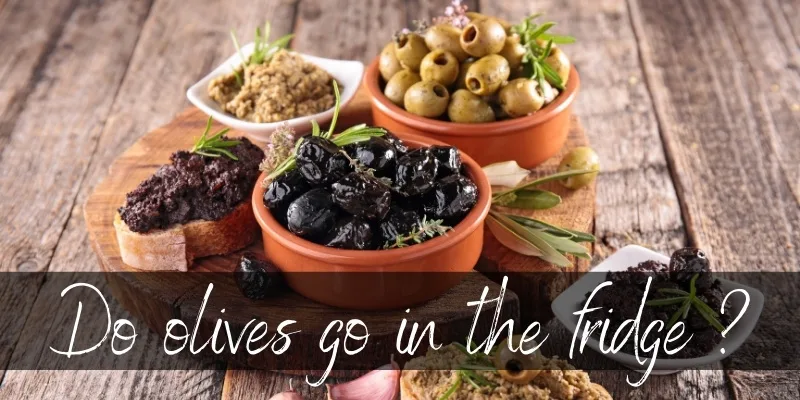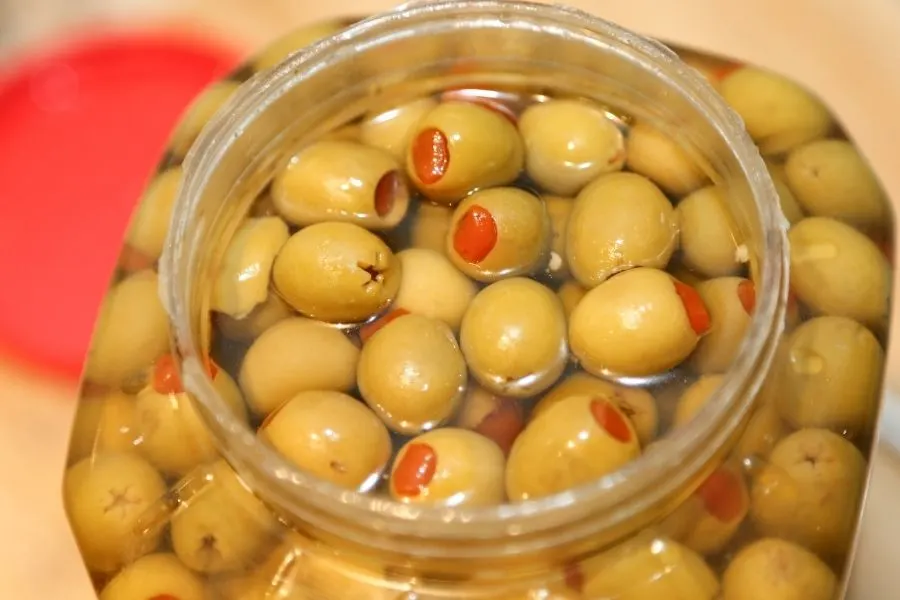Olives are beautiful, flavorful little things and it’s really a shame to waste them. You can get them either by the pound, or pre-packaged in tubs or vacuum bags, or glass jars. And if you don’t end up eating them all in one go – most people don’t – you may be wondering just how to store these things.
Should olives be refrigerated ? It doesn’t always say so, and you always find them placed on a shelf. So how should you store them, and how long do they last ? Let’s take a look.

Should olives be refrigerated ?
Yes, for the best shelf life you should always refrigerate your olives, even if the label does not explicitly state this. The reason olives go in the fridge is that it slows down the spoiling process, by keeping them at a very low temperature.
Olives are usually kept on a counter at room temperature in the supermarket, but those are sealed jars. Once you open the jars, you cannot keep them at room temperature. Mold may form on the dry part of the jar, and contaminate the brine as well.
Storing a jar or tub of olives in the fridge ensures several weeks of flavor, before their taste starts to change a little. As time goes on, you may notice your olives are starting to taste a bit off, but you wouldn’t call them expired. The truth is, olives can last weeks, even months, before they can cause any harm. But they usually change their flavor after about 2 weeks in the fridge, if they are not covered by brine.
How long do jarred olives last ?
Jarred olives, kept in brine, are good for several months if handled properly, with clean utensils whenever you pick them out of the jar. If you remove the brine they can start to change their flavor within 2 weeks, after which they may not be as delicious as they first were.
An unopened jar of olives usually has a ‘best by’ date that you can trust. That date is usually around 12 months after production date at least.
The brine acts as protection for the olives
When olives are packed in brine, it’s done for a couple of reasons. First, it prevents the olives form oxidizing, by not letting them touch the air. Second, it keeps them in a high-salt solution that keeps mold and bacteria at bay. That being said, mold can develop on the sides of the jar, around the lid if it’s not clean.

Read also: Tomato Substitutes
So when you get a jar of olives and want to have a few, you’ll be tempted to strain out the brine. If you do this, make sure you eat the olives within 2 weeks, otherwise they will change their flavor and may even get a bit wrinkly.
Why do olives get white spots ?
There are a couple of reasons your olives get white spots, and it’s usually the green ones that do this. One reason is the accumulation of tiny droplets of olive oil, but this means the olives were stored in a very, very cold temperature for several days. This is not the most common reason, but it’s completely possible in some occasions.
The second reason, most likely, is an accumulation of a friendly yeast that contributed to fermenting the olives in the first place. You see, green olives are usually processed vie Seville or Spanish method. This means fermenting the olives and allowing a yeast culture to develop so they are fully fermented.
Then the olives are rinsed and placed in a fresh, new brine that has no yeast colony. This is how the olives arrive on the shelves in supermarkets. And when you remove the brine at home and keep them for a few days, the leftover yeast will form into tiny white spots.
Are they harmful ? No, not really. This yeast is what contributes to the fermentation process, so it’s part of the olives anyway. And if it’s bits of olive oil, that is not a problem either. They usually form when the brine is no longer covering the olives, and this may change the flavor a little.
You can easily remove the white spots on an olive by rinsing in cold, running water. You will also lose some salt and flavor from the olives.
Why are olives stuffed with pimiento ?
The original idea behind stuffing green, salty-and-sour olives with red bell peppers was to balance the flavors. Red bell peppers are sweet, so they can help mellow out the green olives. Over time, the stuffing became very popular, and now it’s a paste made of red bell peppers, so it can better fit inside the olive.
This gave way to different types of olive stuffing, like bits of garlic, roast almonds, feta cheese, blue cheese, anchovies, hot peppers, and so on.
Ways to use olive brine
Olives, of any kind, usually come packed in a brine. For kalamata and green olives, that beautifully salty-sour brine is too good to just throw out, so you can use it instead. What can you do with it, you ask ? Well it manages to add a whole lot of umami to whatever you’re cooking (or drinking). Just hold off on the salt, and taste as you go. Take a look.
1. Use it in a stew or gumbo
Adding green olives to a thick stew or gumbo is kind of our thing, especially if it’s with a dark meat like beef. The brine from the olives makes the entire meal a bit easier to digest, and cut right through all that richness. How much you use is up to you, but re recommend adding a little at a time, and letting it simmer for a few minutes and only then tasting.
Keep in mind the brine is also salty, so don’t add any other salt until you’re sure you won’t add any more brine.
2. Make a dirty Martini
A dirty Martini relies on a bit of olive brine to make the drink cloudy, and give it a nice twist from the original. It’s definitely not for everyone, since the flavor is fairly different. You don’t need a lot of brine, just a bit, but it’s enough to change the overall flavor.
3. Add it to a sauce or salad dressing
You can make a nice salad dressing out of olive brine, without adding the actual olives to the salad. You can try a vinaigrette where you still use olive oil and vinegar, but replace 2/3 of the vinegar with olive brine.
Or you can mix a bit of honey mustard with the olive brine to get a different flavor, or mix it into a ranch dressing. Really, the possibilities are endless, as long as you put your mind to it.
In short, olives and their brine are delicious and they can last for quite a few months in the fridge if you always use clean utensils to fish out the olives. Even if you don’t want to keep the brine in the jar, there are ways to use it.

